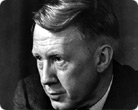President of CBS from 1946 until 1971, Dr. Frank Stanton was a major innovator of mass-media practices. He applied his education in psychology and statistics, developing more effective procedures for mass communication and audience research. Stanton's position gave him political weight, which he used both to support and oppose the government.
Stanton was born in Muskegon, Michigan, in 1908. As a teenager, he worked long hours doing advertising and displays for a clothing store. In 1930 he received his B.A. at Ohio Wesleyan University, where he became interested in radio advertising and psychology. After marrying his high-school sweetheart Sarah "Ruth" Stephenson, Stanton went to Ohio State University for his Ph.D. in psychology, studying people's reactions to various audio and visual stimuli and which forms of transmitting information were most effective. Seeking funding, he wrote to CBS about his invention of a recorder that measured radio-listening behavior. He received an invitation to visit, and later, in 1935, Stanton, degree in hand, joined CBS's research department.
Stanton soon became a vice president and in 1946 was promoted to president by Chairman William Paley. Though Paley continued to lead CBS in many ways, it was Stanton who broke new ground, particularly in the fields of news documentaries and demographic research. An early believer in the power of television—especially in color—Stanton became a champion of quality broadcast journalism in the public interest. Despite earlier involvement in drawing up media blacklists, Stanton defended Edward R. Murrow's 1954 exposť of Senator Joseph McCarthy on the news program See It Now. Four years later, President Eisenhower named Stanton administrator of the Emergency Communications Agency in the shadow government that was to assume power in case of nuclear attack. Stanton also broadcast the first televised presidential debate, between Richard Nixon and John F. Kennedy in 1960, after leading an eight-year battle to repeal a section of the Federal Communications Act that required equal time for all candidates. Following CBS's 1971 airing of "The Selling of the Pentagon," a documentary about the military's misuse of public funds, an outraged White House subpoenaed all the filmmakers' materials. Risking jail, Stanton refused, insisting that television reporters deserved the same First Amendment protection as print journalists.
Despite his career at CBS, Stanton still kept his hand in independent communications research, often in partnership with the eminent psychologist Dr. Paul Lazarsfeld. These experiences led Stanton to help establish the Center for Advanced Study in Behavioral Sciences in Stanford, which grants scholars the time and freedom to pursue new research. From 1958 until 1978, Stanton was a trustee (and for six years, the chair) of the RAND Corporation , a national-security think tank with great influence on government policy. He also helped found the Lincoln Center for the Performing Arts and was chairman of the American Red Cross (1973–79) and vice chairman of the League of Red Cross Societies in Geneva. Among his many awards are a Lifetime Achievement Award from the National Academy of Television Arts and Sciences and five Peabodys. Columbia University recorded his reminiscences in the 1990s. Since his wife's death in the early 1990s, Stanton has lived in Boston, Massachusetts.















